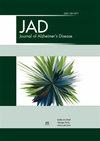血清胎盘生长因子是阿尔茨海默病脑血管疾病负担的标志物
IF 3.4
3区 医学
Q2 NEUROSCIENCES
引用次数: 0
摘要
背景:伴发脑血管疾病(CeVD)已被确定为阿尔茨海默病(AD)进展的重要决定因素。开发稳健的血液生物标记物将为评估伴有 CeVD 的阿尔茨海默病的预后和潜在干预策略提供重要工具。研究目的本研究调查了亚洲非痴呆者记忆诊所队列中的循环胎盘生长因子(PlGF)(一种与内皮功能障碍和血管炎症有关的强效促血管生成因子)以及 AD 的情况,包括其与 CeVD 神经影像标记物的关联。方法:这项横断面研究纳入了 109 名注意力缺失症患者、76 名无痴呆认知功能受损者(CIND)和 56 名非认知功能受损者(NCI)。所有受试者都接受了 3T 脑磁共振成像,以评估白质高密度(WMH)、裂隙、皮质梗死和脑微出血(CMB)。采用电化学发光免疫测定法测定血清 PlGF 浓度。结果显示与NCI对照组相比,AD患者血清PlGF升高,而CIND患者不升高。调整后的 PlGF 浓度只有在存在显著 CeVD 的情况下才与 AD 相关。PlGF升高与AD患者较高的WMH负荷和CMB显著相关。结论:血清PlGF可作为AD中存在CeVD(特别是WMH和CMBs)的生物标志物。还需要进一步的研究来阐明PlGF与CeVD之间的潜在病理生理机制,并进一步评估PlGF的临床实用性。本文章由计算机程序翻译,如有差异,请以英文原文为准。
Serum Placental Growth Factor as a Marker of Cerebrovascular Disease Burden in Alzheimer’s Disease
Background: Concomitant cerebrovascular diseases (CeVD) have been identified as an important determinant of Alzheimer’s disease (AD) progression. Development of robust blood-based biomarkers will provide critical tools to evaluate prognosis and potential interventional strategies for AD with CeVD. Objective: This study investigated circulating placental growth factor (PlGF), a potent pro-angiogenic factor related to endothelial dysfunction and vascular inflammation, in an Asian memory clinic cohort of non-demented individuals as well as AD, including its associations with neuroimaging markers of CeVD. Methods: 109 patients with AD, 76 cognitively impaired with no dementia (CIND), and 56 non-cognitively impaired (NCI) were included in this cross-sectional study. All subjects underwent 3T brain magnetic resonance imaging to assess white matter hyperintensities (WMH), lacunes, cortical infarcts, and cerebral microbleeds (CMBs). Serum PlGF concentrations were measured by electrochemiluminescence immunoassays. Results: Serum PlGF was elevated in AD, but not CIND, compared to the NCI controls. Adjusted concentrations of PlGF were associated with AD only in the presence of significant CeVD. Elevated PlGF was significantly associated with higher burden of WMH and with CMBs in AD patients. Conclusions: Serum PlGF has potential utility as a biomarker for the presence of CeVD, specifically WMH and CMBs, in AD. Further studies are needed to elucidate the underlying pathophysiological mechanisms linking PlGF to CeVD, as well as to further assess PlGF’s clinical utility.
求助全文
通过发布文献求助,成功后即可免费获取论文全文。
去求助
来源期刊

Journal of Alzheimer's Disease
医学-神经科学
CiteScore
6.40
自引率
7.50%
发文量
1327
审稿时长
2 months
期刊介绍:
The Journal of Alzheimer''s Disease (JAD) is an international multidisciplinary journal to facilitate progress in understanding the etiology, pathogenesis, epidemiology, genetics, behavior, treatment and psychology of Alzheimer''s disease. The journal publishes research reports, reviews, short communications, hypotheses, ethics reviews, book reviews, and letters-to-the-editor. The journal is dedicated to providing an open forum for original research that will expedite our fundamental understanding of Alzheimer''s disease.
 求助内容:
求助内容: 应助结果提醒方式:
应助结果提醒方式:


